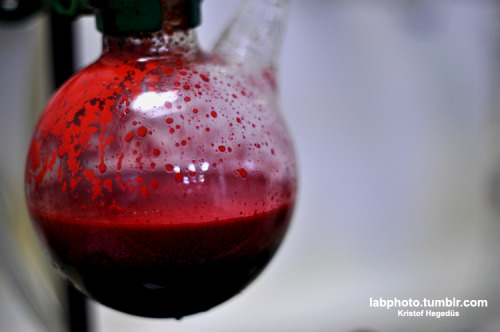patient zero
Harmless

Posts: 8
Registered: 24-2-2013
Location: earth
Member Is Offline
Mood: No Mood
|
|
Note on Amalgams in Reductions
I just wanted to point out, that in general it is not necessary to prepare Hg(II)Cl2 salts (or Hg(I)Cl ) if metal-amalgam is needed for a reduction
(or whatever).
Everyone who ever tried making Hg(II)Cl2, surely knows that this is a dangerous thing to do. Much can go wrong.
Moreover if you made large quantities of mercury-salts, well then you HAVE them.

That's not always a good thing because they are in general more dangerous to have around, than elemental mercury.
However I just wanted topoint out, that no such reaction is really necessary if you have elemental mercury and just want, lets say aluminium amalgam a
la Shulgin, or something like that.
My advice is, stay with your elemental mercury and prepare just as much mercury
NITRATE as you need right before you need it in your amalgamation. From a
practical and safety POV, this is favorable.
Both Hg(II) and Hg(I) nitrates are very soluble and easy to be made and will work
in amalgamation even better the Hg(II)Cl2.
The process is as follows:
- Wear gloves!
- Put your elemental mercury into a test tube.
(Take half of the weight you would take Hg(II)Cl2, because nitrates
amalgamates more rapid)
- Add nitric acid. (Concentration isn't that much of a problem as long as it is not
to deluted. For example 38% works fine. ... Because Hg(I)Cl is soluble, too)
- If necessary, swirl the tube until everything is dissolves.
Protection against NOx is normally not required, because, we deal here just with
a few mL of nitric acid. Anyway don't inhale the vapor, of course.
Thats it.
Stear this now clear liquid into your required amount of water and use it as usual, i.e put it over your aluminium (or xx-metal). This little
additional nitric acid, shouldn't be a problem.It reacts with the first parts of the AlOH or is washed away
later on.
Attention! The amalgamation starts very fast.
Comment:
- All you really need, is a soluble mercury ion and both nitrates of it are.
- You skip all the steps in the Hg(II)Cl2 process
- You make only a small amount at a time. No need to store those poisons.
- Try it. I'm pretty sure, you will come to the conclusion, that its ability to
amalgamate is superior, related to Hg(II)Cl2.
===============================================
Ok. Now please keep the rinsed water of the amalgam washes. If the reaction
is finished and you separated the grey sludge from you products. Put that sludge
into the water of the washes and add hydrochloric acid unit the sluge dissloves.
After some time, a few mercury spots will appear at the bottom of your flask.
You can roll them together and get them out of the liquid, to reuse them.
This way, very little mercury will get into the environment, if you drain down the
liquid (which I don't want you to do, but which you will anyway.)
[Edited on 25-2-2013 by patient zero]
[Edited on 25-2-2013 by patient zero]
|
|
|
patient zero
Harmless

Posts: 8
Registered: 24-2-2013
Location: earth
Member Is Offline
Mood: No Mood
|
|
I just want to push this thought into the web, because I once made a lot of Hg(II)Cl2 and I
always considered this a big mistake. I never needed that much, but now its standing around here, dangerous as it is...
|
|
|
kristofvagyok
National Hazard
   
Posts: 659
Registered: 6-4-2012
Location: Europe
Member Is Offline
Mood: No Mood
|
|
Nowdays I am making some organomercury chemistry and I usually start with Hg(OAc)2 what could be also a good starting point for amalgam reductions,
although I know that it's aint so easy to get for a home chemist.
An important note for mercury related chemistry: always have some potassium or sodium iodide solution near to you, because if something goes wrong
simply adding the KI will lead to the participation of the nearly insoluble HgI2. Also it is working great to detect Hg salts what could have
accidentally spilled on your e.g.: hands.
If working with organomercury compounds like R-Hg-X where R is an organic group and X is an anion use KI3 instead of KI!
My reactions are stopped by adding some KI3 soln. where the mercury participates out as HgI2:

I have a blog where I post my pictures from my work: http://labphoto.tumblr.com/
-Pictures from chemistry, check it out(:
"You can’t become a chemist and expect to live forever." |
|
|
|